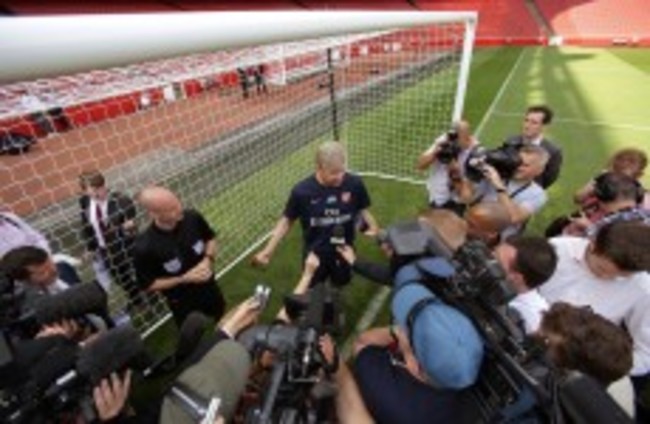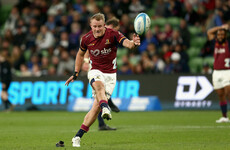At least England’s humbling 4-1 defeat to Germany in the 2010 World Cup can now be remembered as something other than the latest in a long line of national humiliations.
As football executives gathered at Arsenal’s Emirates stadium to unveil Goal Decision System technology that will this season enable referees to definitively rule on whether a ball has crossed the line, Premier League chief executive Richard Scudamore revealed it was Frank Lampard’s “ghost goal” in that match that secured its introduction.
From Sir Geoff Hurst’s extra time goal in the 1966 World Cup final, which famously went England’s way, to Lampard’s shot in South Africa, which did not, goal line controversies have provided a rich source of debate and frustration for football fans down the decades. The Football Association and the Premier League have been lobbying for more than a decade for the introduction of technology that would end such controversies. They carried out extensive tests in 2006 on the Hawk-Eye system used in tennis and cricket.
But until Lampard embarrassed Fifa, international football’s ruling body, in Bloemfontein, its president Sepp Blatter had insisted that football must retain a “human face”. Michel Platini, president of Uefa, which represents football in Europe, remains against the technology, and it will not be used in the Champions League or other European competitions, but last year it was decided that competition organisers could decide whether to employ it or not.
“Thanks to Frank Lampard and the World Cup in 2010, the mood changed somewhat. Even Mr Blatter, and certainly [Fifa general secretary] Jerome Valcke, thought this was crazy and was damaging their competition,” said Scudamore, standing at the Emirates where the technology was being demonstrated.
“We got a bit of renewed energy and vigour and Fifa did change their mind. They licensed four companies, and we’ve contracted with Hawk-Eye to go into Premier League grounds.”
The Premier League has invested more than £2m installing the Hawk-Eye cameras in all 20 grounds. Within a second of the ball crossing the line, the referee will receive a signal to a special watch that would not look out of place in a 1960s episode of Star Trek and hear “goal, goal, goal” relayed to an earpiece.
The system is accurate to within 4mm and, claim its inventors, can accurately locate the ball even when it is all but entirely obscured. Unlike some rival systems, it has the advantage that there is no need to adapt the ball, the goal posts or the playing surface.
According to the Premier League, there were 31 occasions where it would have been used last season and three in which the technology would have resulted in a different decision to that given by the referee.
It will be used in Sunday’s traditional Community Shield showpiece at Wembley between champions Manchester United and FA Cup winners Wigan Athletic before being employed for England’s friendly with Scotland next week and then all 380 Premier League matches from 17 August.
A graphical representation of the decision will be made available to broadcasters and for use on the big screens within stadiums inside 20 seconds. “What’s most important is that the fundamental reason people play football is to get the ball into the net and score a goal,” said Scudamore. He dismissed suggestions that the technology would lead to calls for it to be used in more subjective decisions over offside or fouls.
“This technology is specifically designed for one purpose. This has only been approved and installed to make that one decision. The discussion will rage on about many things in football. Nothing will stop all that. This is a discrete technology for a specific decision.”
FA general secretary Alex Horne also denied it would prove to be the thin end of a large wedge and lead to calls for technology to be used in other parts of the game, as in rugby and cricket.
“We need to be very careful about what other decisions we think it is appropriate for. I don’t want to undermine the referees and you can reach a position in other sports where referees are reliant on technology and their roles are a little bit confused,” he said. “You have to be really careful what supports them and what undermines them.”
Premier League referee Anthony Taylor said the system had been welcomed by referees. And while it should subtract one strand of controversy from post-match discussions, Arsenal manager Arsene Wenger, ambling over prior to leading a training session on the pitch, immediately accosted Taylor in a manner that suggested it will not remove it altogether.
“Is it quick enough? The ball goes in, comes out, it’s a foul on the defender, he decides to give the foul on the defender and suddenly the watch vibrates,” pondered Wenger.
“Is it enough time? That could happen realistically. Intellectually it could happen.
“At the moment there is a delay between the moment the ball goes in and the moment where the referee is told the ball goes in.”
But ultimately Wenger said he approved of the technology. “The only important thing is justice. I’m very happy and I hope we will make the watch work a lot,” he smiled. “Though now that they have it I’m sure not one incident will happen this season.”
© Guardian News & Media Limited 2014











This is definitely going to make rigging games more difficult for Sap Blatter and the boys. End of an era…
Two great things happened the day Germany knocked England out of the World Cup. One FIFA realised that goal line technology had to be introduced in soccer. Two the most important of all. Meath scored 5 goals against the dubs. What a great day that was.